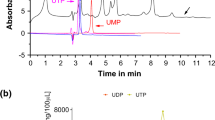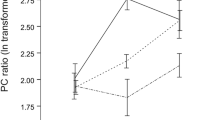Abstract
The European shore crab Carcinus maenas is considered to rely on a female pheromone when mating. Evidence, however, is scarce on how the urine pheromone in itself affects males. We investigated male primer and releaser responses to female pheromones with methods that minimized effects from females, delivering female urine either as a pump-generated plume or deposited on a polyurethane sponge. We delivered the pheromone at different concentrations in far, near, and close/contact range to get a picture of how distance affects behavioral response. Our results show that substances in premolt female urine (PMU) function as primer and potent short-range releaser pheromones. Based on the olfactometer and sponge tests, we conclude that PMU stimulus in itself is sufficient to elicit increased search and mating-specific behaviors such as posing, posing search, cradle carrying, and stroking. Pheromone concentrations do not seem to be important for attenuating search and posing as long as the level is above a certain threshold concentration. Instead, pheromone levels seem to play a role in male acceptance of females, recruiting more males to respond, and generating better responses with increasing concentration.





Similar content being viewed by others
References
P. Abello C. G. Warman D. G. Reid E. Naylor (1994) ArticleTitleChela loss in the shore crab Carcinus maenas (Crustacea: Brachyura) and its effect on mating success Mar. Biol. 121 247–252
N. Asai N. Fusetani S. Matsunaga J. Sasaki (2000) ArticleTitleSex pheromones of the hair crab Erimacrus isenbeckii. Part 1: Isolation and structures of novel ceramides Tetrahedron 56 9895–9899
J. Atema D. G. Engstrom (1971) ArticleTitleSex pheromone in the lobster Homarus americanus Nature 232 261–263
S. D. Bamber E. Naylor (1996a) ArticleTitleChemical communication and behavioural interaction between sexually mature male and female shore crabs (Carcinus maenas) J. Mar. Biol. Assoc. UK 76 691–699
S. D. Bamber E. Naylor (1996b) ArticleTitleMating behavior of male Carcinus maenas in relation to a putative sex pheromone: Behavioural changes in response to antennule restriction Mar. Biol. 125 483–488
S. D. Bamber E. Naylor (1997) ArticleTitleSites of release of putative sex pheromone and sexual behavior in female Carcinus maenas (Crustacea: Decapoda) Estuar. Coast. Shelf Sci. 44 195–202
P. J. Bushmann (1999) ArticleTitleConcurrent signals and behavioral plasticity in blue crab Callinectes sapidus Rathbun courtship Biol. Bull. 197 63–71
J. P. Christofferson (1978) ArticleTitleEvidence for the controlled release of a crustacean sex pheromone J. Chem. Ecol. 4 633–640
N. B. Davies (1991) Mating systems J. R. Krebs N. B. Davies (Eds) Behavioural Ecology: An Evolutionary Approach Blackwell UK 263–294
E. R. Diaz M. Thiel (2004) ArticleTitleChemical and visual communication during mate searching in rock shrimp Biol. Bull. 206 134–143
S. B. Doernberg S. I. Cromarty R. Heinrich B. S. Beltz E. A. Kravitz (2001) ArticleTitleAgonistic behavior in naive juvenile lobsters depleted of serotonin by 5,7-dihydroxytryptamine J. Comp. Physiol., A 187 91–103
A. J. Eales (1974) ArticleTitleSex pheromone in the shore crab Carcinus maenas and the site of its release from females Mar. Behav. Physiol. 2 345–355
D. J. C. Fletcher M. S. Blum (1981) ArticleTitlePheromonal control of dealation and oogenesis in virgin queen fire ants Solenopsis invicta Science 212 73–75
R. A. Gleeson (1980) ArticleTitlePheromone communication in the reproductive behavior of the blue crab Callinectes sapidus Mar. Behav. Physiol. 7 119–134
R. A. Gleeson (1991) Intrinsic factors mediating pheromone communication in the blue crab Callinectes sapidus R. T. Bauer J. W. Martin (Eds) Crustacean Sexual Biology Columbia University Press New York 17–32
R. A. Gleeson M. A. Adams A. B. Smith III SuffixIII (1984) ArticleTitleCharacterization of a sex pheromone in the blue crab Callinectes sapidus crustecdysone studies J. Chem. Ecol. 10 913–922
C. M. Grozinger N. M. Sharabash C. W. Whitfield G. E. Robinson (2003) ArticleTitlePheromone-mediated gene expression in the honey bee brain Proc. Natl. Acad. Sci. USA 100 14519–14525
J. D. Hardege A. Jennings D. Hayden C. T. Muller D. Pascoe M. G. Bentley A. S. Clare (2002) ArticleTitleNovel behavioural assay and partial purification of a female-derived sex pheromone in Carcinus maenas Mar. Ecol., Prog. Ser. 244 179–189
R. G. Hartnoll (1969) ArticleTitleMating in the Brachyura Crustaceana 16 162–181
S. Hayes D. P. Costa J. T. Harvey B. J. Boef ParticleLe (2004) ArticleTitleAquatic mating strategies of the male Pacific harbor seal Phoca vitulina richardii: Are males defending the hotspot? Mar. Mamm. Sci. 20 639–656
B. A. Hazlett (1996) ArticleTitleReproductive behavior of the hermit crab Clibanarius vittatus (Bosc, 1802) Bull. Mar. Sci. 58 668–674
J. T. Hoeg (1995) ArticleTitleThe biology and life cycle of the Rhizocephala (Cirripedia) J. Mar. Biol. Assoc. UK 75 517–550
S. Holm (1979) ArticleTitleA simple sequentially rejective multiple test procedure Scand. J. Statist. 6 65–70
M. Hovi R. V. Alatalo M. Halonen A. Lundberg (1997) ArticleTitleResponses of male and female black grouse to male vocal display Ethology 103 1032–1041
E. Iwata Y. Wakabayashi Y. Kakuma T. Kikusui Y. Takeuchi Y. Mori (2000) ArticleTitleTestosterone-dependent primer pheromone production in the sebaceous gland of male goat Biol. Reprod. 62 806–810
P. Jivoff A. H. Hines (1998) ArticleTitleEffect of female molt stage and sex ratio on courtship behavior of the blue crab Callinectes sapidus Mar. Biol. 131 533–542
Y. Kamiguchi (1972) ArticleTitleMating behavior in the fresh water prawn Palaemon paucidens a study of the sex pheromone and its effect on males J. Fac. Sci., Hokkaido Univ., Ser. 6 18 347–355
M. Kamio S. Matsunaga N. Fusetani (2000) ArticleTitleStudies on sex pheromones of the helmet crab, Telmessus cheiragonus 1. An assay based on precopulatory mate-guarding Zool. Sci. 17 731–733
E. A. Kravitz (1988) ArticleTitleHormonal control of behavior amines and the biasing of behavioral output in lobsters Science 241 1775–1781
Y. Conte ParticleLe A. Mohammedi G. E. Robinson (2001) ArticleTitlePrimer effects of a brood pheromone on honeybee behavioural development Proc. R. Soc. Lond., B Biol. Sci. 268 163–168
C. Moffatt (2003) ArticleTitleSteroid hormone modulation of olfactory processing in the context of socio-sexual behaviors in rodents and humans Brain Res. Rev. 43 192–206
D. G. Reid P. Abello C. G. Warman E. Naylor (1994) ArticleTitleSize-related mating success in the shore crab Carcinus maenas (Crustacea: Brachyura) J. Zool. 232 397–407
D. G. Reid P. Abello M. J. Kaiser C. G. Warman (1997) ArticleTitleCarapace color, inter-molt duration and the behavioural and physiological ecology of the shore crab Carcinus maenas Estuar., Coast. Shelf Sci. 44 203–211
E. P. Ryan (1966) ArticleTitlePheromone—evidence in a decapod crustacean Science 151 340–341
P. Seifert (1982) ArticleTitleStudies on the sex pheromone of the shore crab Carcinus maenas with special regard to ecdysone excretion Ophelia 21 147–158
L. U. Sneddon F. A. Huntingford A. C. Taylor A. S. Clare (2003) ArticleTitleFemale sex pheromone-mediated effects on behavior and consequences of male competition in the shore crab Carcinus maenas J. Chem. Ecol. 29 55–70
P. W. Sorensen T. A. Christensen N. E. Stacey (1998) ArticleTitleDiscrimination of pheromonal cues in fish: Emerging parallels with insects Curr. Opin. Neurobiol. 8 458–467
N. Stacey (2003) ArticleTitleHormones, pheromones and reproductive behavior Fish Physiol. Biochem. 28 229–235
P. D. Stebbing M. G. Bentley G. J. Watson (2003) ArticleTitleMating behaviour and evidence for a female released courtship pheromone in the signal crayfish Pacifastacus leniusculus J. Chem. Ecol. 29 465–475
A. J. Tierney L. A. Mangiamele (2001) ArticleTitleEffects of serotonin and serotonin analogs on posture and agonistic behavior in crayfish J. Comp. Physiol., A 187 757–767
G. I. Meeren ParticleVan Der (1994) ArticleTitleSex- and size-dependent mating tactics in a natural population of shore crabs Carcinus maenas J. Anim. Ecol. 63 307–314
E. L. M. Vermeirssen A. P. Scott N. R. Liley (1997) ArticleTitleFemale rainbow trout urine contains a pheromone which causes a rapid rise in plasma 17,20-beta-dihydroxy-4-pregnen-3-one levels and milt amounts in males J. Fish Biol. 50 107–119
M. A. Willis M. C. Birch (1982) ArticleTitleMale lek formation and female calling in a population of the arctiid moth Estigmene acrea Science 218 168–217
D. E. Wood (1995) ArticleTitleNeuromodulation of rhythmic motor patterns in the blue crab Callinectes sapidus by amines and the peptide proctolin J. Comp. Physiol., A 177 335–349
D. E. Wood C. D. Derby (1995) ArticleTitleCoordination and neuromuscular control of rhythmic behaviors in the blue crab Callinectes sapidus J. Comp. Physiol., A 177 307–319
D. E. Wood R. A. Gleeson C. D. Derby (1995) ArticleTitleModulation of behavior by biogenic amines and peptides in the blue crab, Callinectes sapidus J. Comp. Physiol., A 177 321–333
H. Yambe M. Shindo F. Yamazaki (1999) ArticleTitleA releaser pheromone that attracts males in the urine of mature female masu salmon J. Fish Biol. 55 158–171
Acknowledgments
We thank Prof. Christer Brönmark, Dr. Almut Kelber, Dr. Jamie Theobald, and two anonymous reviewers for providing constructive criticism on the manuscript. We thank the ever-helpful staff at Klubban Biological Station for providing animals and facilities. Grants from the Royal Physiographic Society in Lund and The Swedish Research Council for Environment, Agricultural Sciences, and Spatial Planning provided financial support.
Author information
Authors and Affiliations
Corresponding author
Rights and permissions
About this article
Cite this article
Ekerholm, M., Hallberg, E. Primer and Short-Range Releaser Pheromone Properties of Premolt Female Urine from the Shore Crab Carcinus maenas. J Chem Ecol 31, 1845–1864 (2005). https://doi.org/10.1007/s10886-005-5930-9
Received:
Revised:
Accepted:
Published:
Issue Date:
DOI: https://doi.org/10.1007/s10886-005-5930-9




